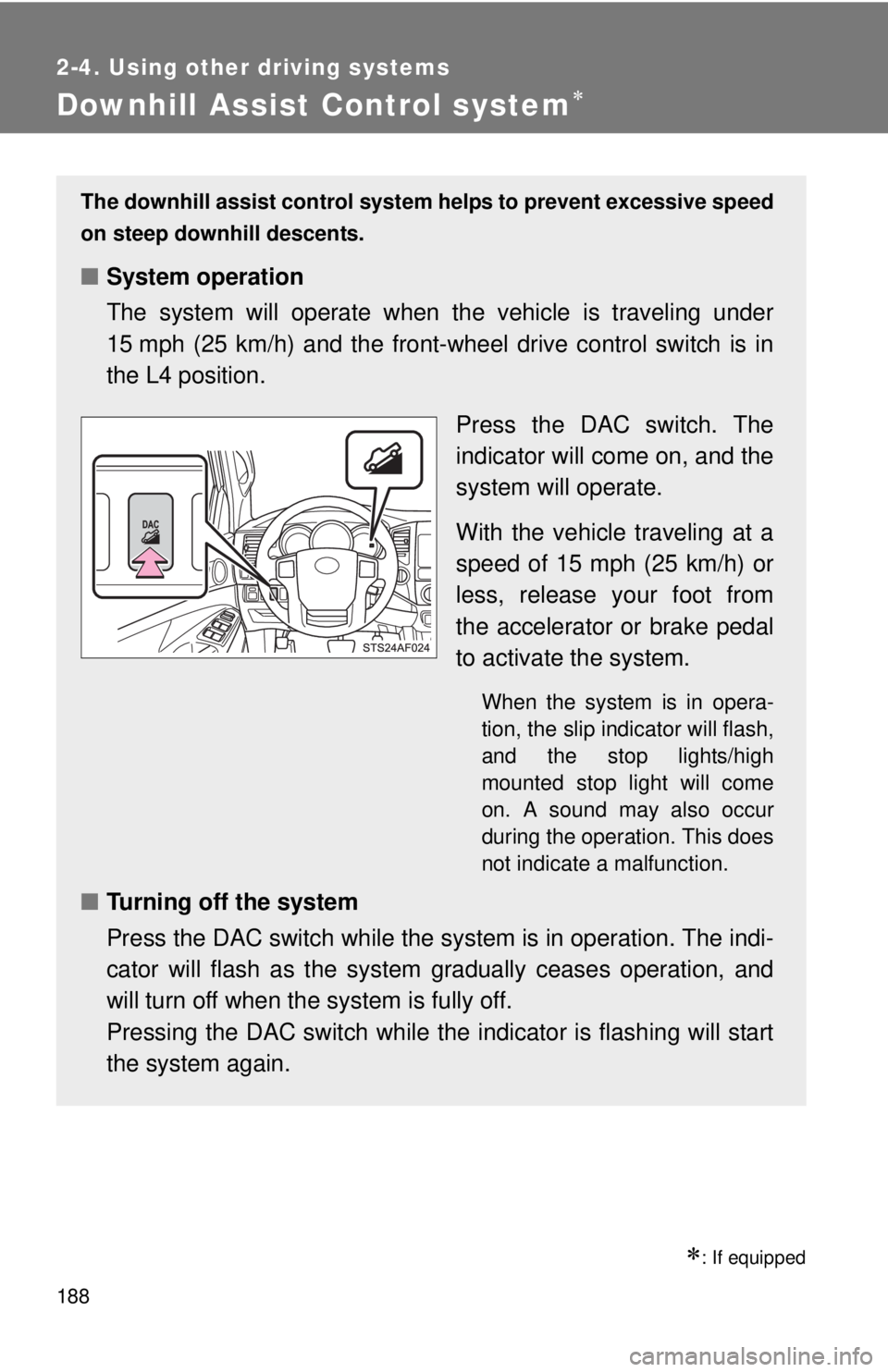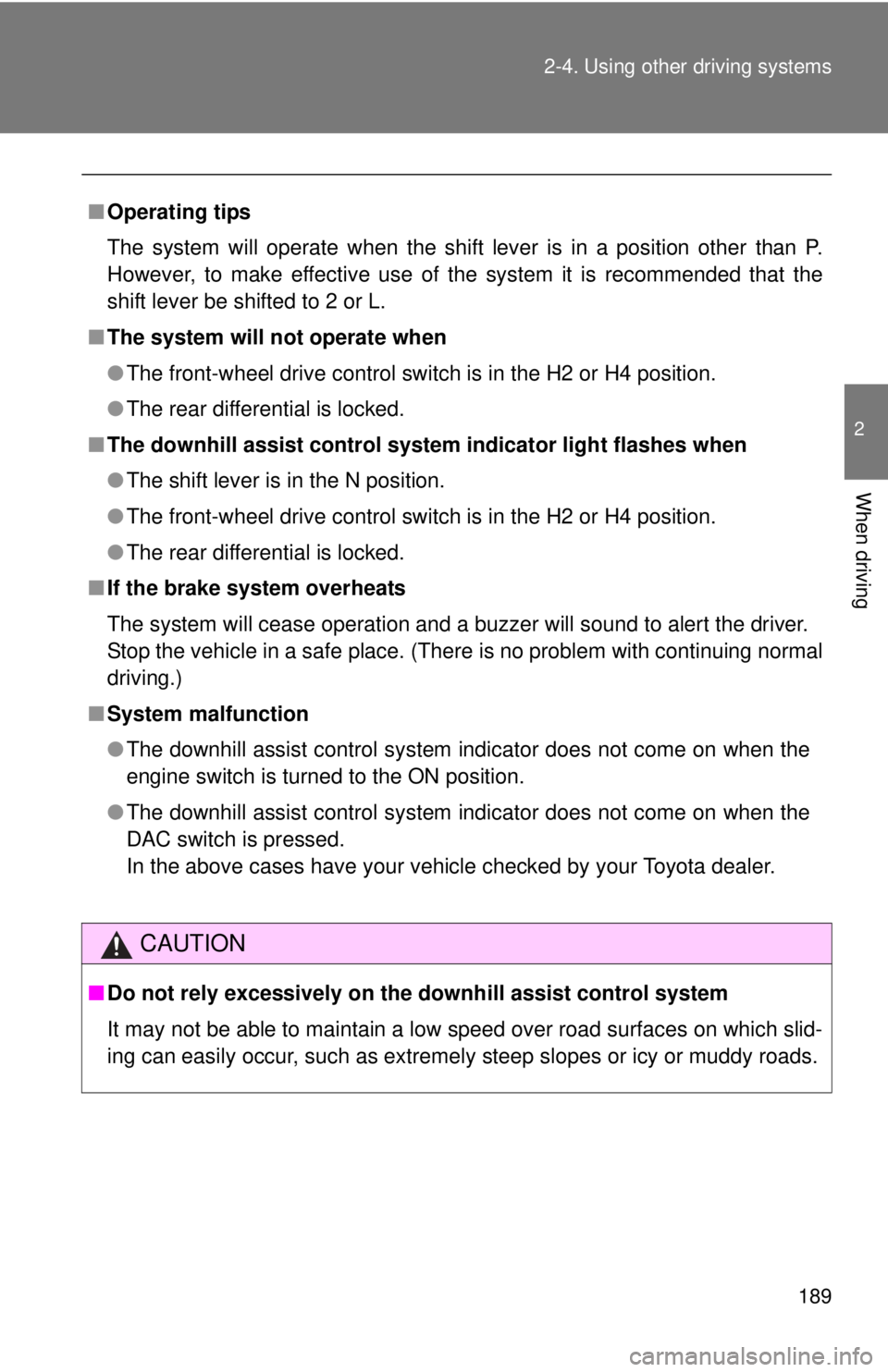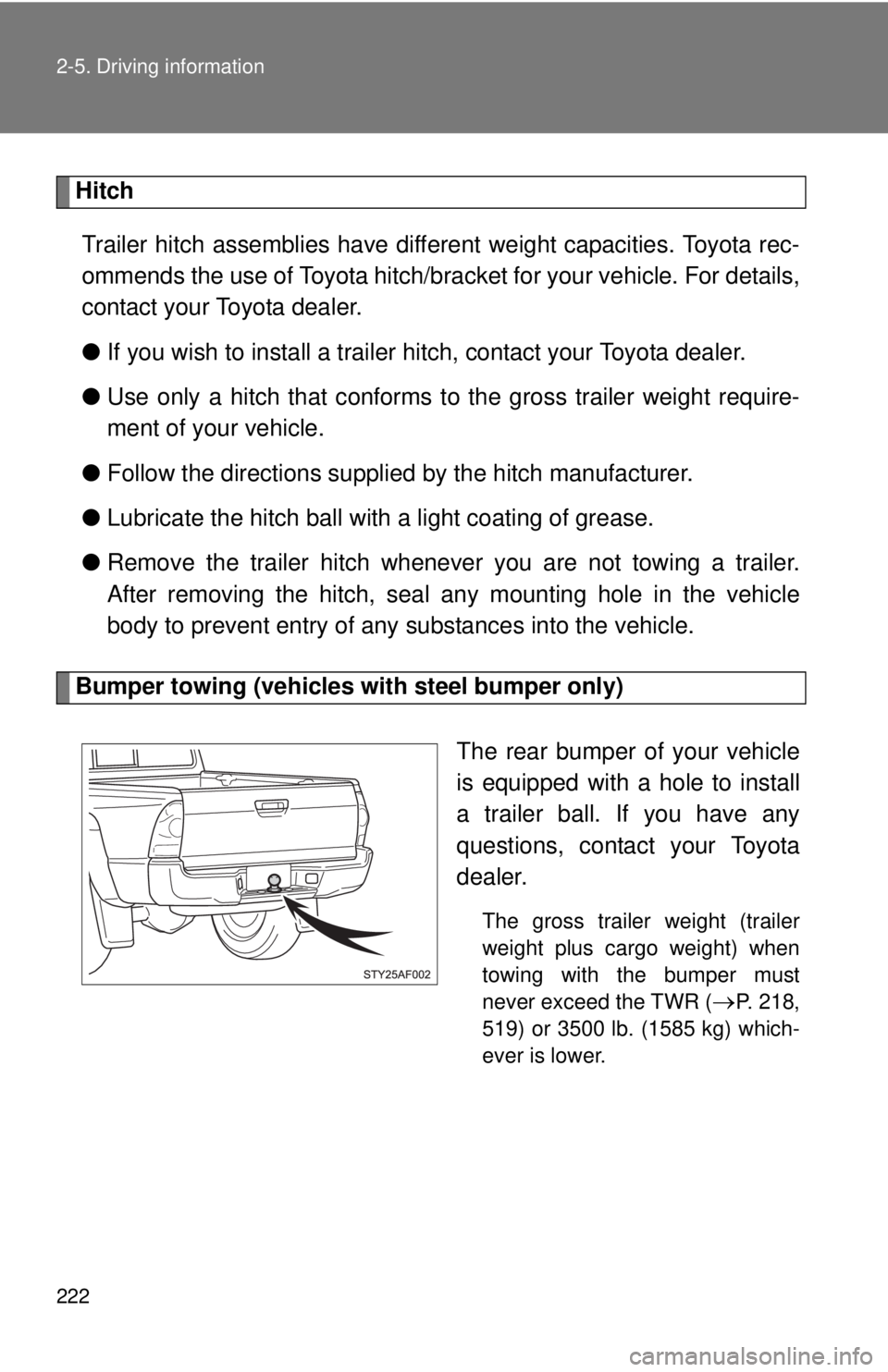Page 188 of 590

188
2-4. Using other driving systems
Downhill Assist Control system
: If equipped
The downhill assist control system helps to prevent excessive speed
on steep downhill descents.
■System operation
The system will operate when the vehicle is traveling under
15 mph (25 km/h) and the front-wheel drive control switch is in
the L4 position.
Press the DAC switch. The
indicator will come on, and the
system will operate.
With the vehicle traveling at a
speed of 15 mph (25 km/h) or
less, release your foot from
the accelerator or brake pedal
to activate the system.
When the system is in opera-
tion, the slip indicator will flash,
and the stop lights/high
mounted stop light will come
on. A sound may also occur
during the operation. This does
not indicate a malfunction.
■Turning off the system
Press the DAC switch while the syst em is in operation. The indi-
cator will flash as the system gradually ceases operation, and
will turn off when the system is fully off.
Pressing the DAC switch while the indicator is flashing will start
the system again.
Page 189 of 590

189
2-4. Using other
driving systems
2
When driving
■Operating tips
The system will operate when the shift lever is in a position other than P.
However, to make effective use of the system it is recommended that the
shift lever be shifted to 2 or L.
■ The system will not operate when
●The front-wheel drive control switch is in the H2 or H4 position.
● The rear differential is locked.
■ The downhill assist control system indicator light flashes when
● The shift lever is in the N position.
● The front-wheel drive control switch is in the H2 or H4 position.
● The rear differential is locked.
■ If the brake system overheats
The system will cease operation and a buzzer will sound to alert the driver.
Stop the vehicle in a safe place. (Ther e is no problem with continuing normal
driving.)
■ System malfunction
●The downhill assist control system indicator does not come on when the
engine switch is turned to the ON position.
● The downhill assist control system indicator does not come on when the
DAC switch is pressed.
In the above cases have your vehicle checked by your Toyota dealer.
CAUTION
■Do not rely excessively on the downhill assist control system
It may not be able to maintain a low speed over road surfaces on which slid-
ing can easily occur, such as extremely steep slopes or icy or muddy roads.
Page 192 of 590
192 2-4. Using other driving systems
When the VSC/Trailer Sway Control/TRAC/hill-start assist control
systems are operatingThe slip indicator will flash while
the VSC/Trailer Sway Con-
trol/TRAC/hill-start assist control
systems are operating.
The stop lights and high mounted
stoplight turn on when the
hill-start assist control system or
Trailer Sway Control is operating.
To disable VSC, Trailer Sway Control and TRAC (2WD models
and 2WD mode on 4WD models)
If the vehicle gets stuck in fresh snow or mud, VSC, Trailer Sway
Control and TRAC may reduce power from the engine to the wheels.
You may need to turn the system off to enable you to rock the vehicle
in order to free it.
■ Turning off TRAC, VSC and Trailer Sway Control
Press and hold the VSC OFF
switch for more than 3 seconds
while the vehicle is stopped to
turn off TRAC, VSC and Trailer
Sway Control.
The VSC OFF and TRAC OFF
indicators will come on.
Push the switch again to turn both
systems back on.
Page 194 of 590

194 2-4. Using other driving systems
■When the TRAC OFF indicator light comes on even if the VSC OFF
switch has not been pressed
TRAC, hill-start assist control, downhill assist control system cannot be oper-
ated. Contact your Toyota dealer.
■ Reactivation of the TRAC, VSC and Trailer Sway Control systems after
turning off the engine
Turning off the engine after turning off the TRAC, VSC and Trailer Sway
Control systems will automatically reactivate them.
■ Automatic TRAC reactivation (AUTO LSD mode)
With AUTO LSD mode, VSC OFF and AUTO LSD indicator lights turn on.
The TRAC system will turn on when the vehicle speed increases.
■ Automatic TRAC, VSC and Trai ler Sway Control reactivation
If the TRAC, VSC and Trailer Sway Control systems are turned off, the sys-
tems will not turn on even when vehicle speed increases.
■ Sounds and vibrations caused by the ABS, TRAC, VSC, Trailer Sway
Control, brake assist and hill-start assist control system
● A sound may be heard from the engine compartment when the engine is
started or just after the vehicle begins to move. This sound does not indi-
cate that a malfunction has occurred in any of these systems.
● Any of the following conditions may occur when the above systems are
operating. None of these indicates that a malfunction has occurred.
• Vibrations may be felt through the vehicle body and steering.
• A motor sound may be heard after the vehicle comes to a stop.
• The brake pedal may pulsate slightly when the ABS is activated.
• The brake pedal may move down slightly after the ABS is activated.
■ Hill-start assist control is op erational when (if equipped)
● The shift lever is in the D, 4, 3, 2 (5-speed automatic transmission), D, 3,
2 (4-speed automatic transmission) or L positions.
● The brake pedal is not depressed.
Page 222 of 590

222 2-5. Driving information
HitchTrailer hitch assemblies have different weight capacities. Toyota rec-
ommends the use of Toyota hitch/brac ket for your vehicle. For details,
contact your Toyota dealer.
● If you wish to install a trailer hitch, contact your Toyota dealer.
● Use only a hitch that c onforms to the gross trailer weight require-
ment of your vehicle.
● Follow the directions supplied by the hitch manufacturer.
● Lubricate the hitch ball with a light coating of grease.
● Remove the trailer hitch whenever you are not towing a trailer.
After removing the hitch, seal any mounting hole in the vehicle
body to prevent entry of any substances into the vehicle.
Bumper towing (vehicles with steel bumper only)
The rear bumper of your vehicle
is equipped with a hole to install
a trailer ball. If you have any
questions, contact your Toyota
dealer.
The gross trailer weight (trailer
weight plus cargo weight) when
towing with the bumper must
never exceed the TWR (
P. 218,
519) or 3500 lb. (1585 kg) which-
ever is lower.
Page 224 of 590
224 2-5. Driving information
Positions for towing hitch receiver and hitch ballWeight carrying ball position:
56.1 in. (1425 mm)
Hitch receiver pin hole posi-
tion: 44.2 in. (1123 mm)
Connecting trailer lightsVehicles with 7 pin connector Use the wire harness stored in
the rear end under the vehicle
body.
Vehicles without 7 pin connector
Please consult your dealer when installing trailer lights, as incor-
rect installation may cause dama ge to the vehicle’s lights. Please
take care to comply with your st ate’s laws when installing trailer
lights.
Page 225 of 590

225
2-5. Driving information
2
When driving
Trailer towing tips
Your vehicle will handle differently when towing a trailer. Help to avoid
an accident, death or serious injury, keep the following in mind when
towing:
● Speed limits for towing a trailer vary by state or province. Do not
exceed the posted towing speed limit.
● Toyota recommends that the vehicle-trailer speed limit is 65 mph
(104 km/h) on a flat, straight, dry road. Do not exceed this limit, the
posted towing speed limit or the speed limit for your trailer as set
forth in your trailer owner’s man ual, whichever is lowest. Instability
of the towing vehicle-trailer combin ation (trailer sway) increases as
speed increases. Exceeding speed limits may cause loss of con-
trol.
● Before starting out, check the trailer lights, tires and the vehicle-
trailer connections. Recheck after driving a short distance.
● Practice turning, stopping and reve rsing with the trailer attached in
an area away from traffic until you become accustomed to the feel
of the vehicle-trailer combination.
■ Service connector for towing brake controller (vehicles with 7 pin con-
nector)
Your vehicle is equipped with a service
connector for the trailer brake controller
as shown.
Page 228 of 590

228 2-5. Driving information
Release the parking brake (and also the brake pedal on vehi-
cles with an automatic transmission), and slowly pull or back
away from the wheel blocks. Stop and apply the brakes.
Have someone retrieve the blocks.
■ Matching trailer ball height to trailer coupler height
■ Before towing
Check that the following conditions are met:
●Ensure that your vehicle’s tires are properly inflated. ( P. 532)
● Trailer tires are inflated according to the trailer manufacturer’s recom-
mendation.
● All trailer lights work as required by law.
● All lights work each time you connect them.
● The trailer ball is set at the proper height for the coupler on the trai\
ler.
● The trailer is level when it is hitched.
Do not drive if the trailer is not level, and check for improper tongue
weight, overloading, worn suspension, or other possible causes.
● The trailer cargo is securely loaded.
No matter which class of tow hitch
applies, for a more safe trailer hookup,
the trailer ball setup must be the proper
height for the coupler on the trailer.
Coupler
Trailer ball